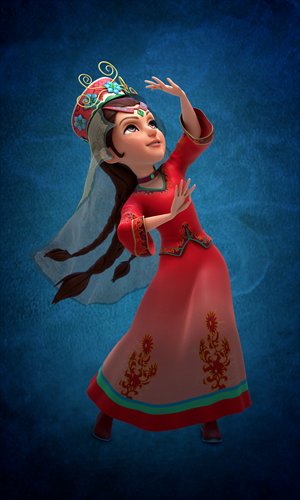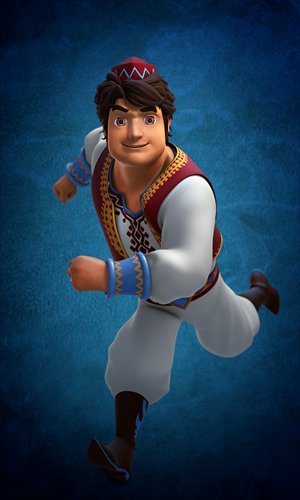Xinjiang fights an ideology war through cartoon production

Ipal Khan, a main character of the cartoon series Princess Fragrant. Photo: Courtesy of Shenzhen Qianheng Cultural Communication Company
Deng Jianglei, director of Princess Fragrant, a 3D-cartoon adapted from the story of a Uyghur princess who married the Qianlong Emperor during the 18th century in a political marriage, has been searching for a musician who can compose and write the lyrics to the title song for over a year.
"The musician has to be accepted both by the communities of Han and Uyghur people, which means he or she has to be familiar with two different cultures and musical styles, which is difficult," Deng, a cartoon director with the Shenzhen Qianheng Cultural Communications Company, told the Global Times.
The production of the cartoon series is part of the Xinjiang authorities' endeavor to develop the animation industry with the aim of maintaining social stability by boosting cultural exchanges and understanding between Han and Uyghur people, especially at a time of rising tension following terrorist attacks in and outside of Xinjiang.
Last year, the company won a tender to cooperate with the government of Kashgar, Xinjiang Uyghur Autonomous Region, to create the animated cartoon that represents a full picture of Xinjiang folk customs and cultural development. The cartoon features a group of heroes led by Ipal Khan, the young "Fragrant Concubine" who fought to protect the heirlooms of her family.
For Deng, a good choice of title song matters greatly.
Previous attempts at the number, offered by companies and musicians from inland cities such as Beijing, Shenzhen and Guangzhou, have failed to satisfy.
"Xinjiang artists who work as consultants for our cartoon vetoed them as having no Xinjiang elements," Deng said.
That was until Deng accidentally ran into Hong Qi, a half-Uyghur musician born and raised in Hotan but developed his music career inland.
As a Uyghur singer, Hong has been well received. Most of his works are inspired by traditional Xinjiang music.
"Hong met almost all of our expectations. He grew up in Xinjiang, knows Xinjiang well and is well accepted by Han people," Deng said.
Deng's is just one of a number of animation companies drawn to explore the new market in far west China in recent years. An aggressive promotion of the animation industry is part of China's endeavor to build soft power.
The global industry is valued at over $200 billion, and the output of its derivatives amounts to over $500 billion a year. China has seen a rising cartoon market valued at 200 billion yuan ($32.52 billion) each year, statistics show.
Preferential policies, including subsidies and tax-free incentives have been implemented in Xinjiang to attract such companies.
"Xinjiang's cartoon industry can use this opportunity to develop its own market," said Sheng Jun, a deputy director of cultural industry office at the Xinjiang Bureau of Culture.
The problem, Sheng said, is "culture shock."

Tuerdo, a main character of the cartoon series Princess Fragrant. Photo: Courtesy of Shenzhen Qianheng Cultural Communication Company
Knowledge gap
For Deng and his team, most of whom are Han people, the difficulties in finding the right musician is simply indicative of a whole host of similar problems.
"A common difficulty for artists from outside of Xinjiang who love Xinjiang and want to promote it to the outside world is that they don't know anything about Xinjiang," 41-year-old Hong Qi told the Global Times.
"They have little understanding of Xinjiang's music. Misunderstandings might cause severe cultural conflict,"Hong told the Global Times.
For instance, it has become common practice to adopt animal characters in cartoons.
However, the use of firstly a snake, then a squirrel in Princess Fragrant, aroused objection from Uyghur artists in the team.
"Snake are regarded as evil in Islamic culture and Uyghur families seldom keep pets, unlike Han people," Hong said.
Eventually, for the sake of the market, Deng insisted on using an animal character.
"It's all about compromise. There are some conservative artists in Xinjiang who cannot accept the adoption of post-modern concepts," Deng said.
Transcending time and space with time machines is a common plot device in cartoons. But local Uyghur artists were strongly against the concept.
"The difficulty is that you have to respect history and culture while catering to the market. Both are important and you cannot neglect either side," Shenzhen Qianheng president Luo Lijian told the Global Times.
The alienation of Han people to Islamic culture, shortage of manpower and over-emphasis on the educational function of animation have thwarted the development of the animation in Xinjiang.
To solve these problems, Han artists have to do a lot of preparation before they enter into Xinjiang's cartoon market.
When Huang Zhiyong, director of Loulan Legend, based on the rise and fall of the Loulan kingdom, built in 176 BC, tested the waters with Xinjiang's first local cartoon last year, he spent over half a year in Xinjiang before he even started.
"At the very beginning, I had little knowledge of Xinjiang and I spent a large amount of time wandering around in the big bazaar and the Uyghur-populated areas, as well as the museums," Huang said.
He visited the relics of Loulan frequently and read a large number of local archives before he started to make the cartoon, Huang said.
With rich cultural resources and ethnic legends, Xinjiang abounds with good material for the cartoon industry. With eight neighboring Central Asian countries, the geological location also offers unique opportunities for the Xinjiang region to develop its cartoon industry in Central Asia.
Qarluq Technology Company is the first animation company established in Xinjiang that focuses on 3D productions. The company, most of whose employees are Uyghur people, has been expanding its market in foreign countries, including Iran, Kazakhstan and other countries, by using its language and geological advantages.
"We have cultural closeness with neighboring and Middle East countries. To promote a modern and open Xinjiang to the world is the aim of our cartoon works," Azizaim Abudulah, director of operational department from Qarluq company, told the Global Times.
Azizaim noted a lack of manpower and expensive equipment has become a hurdle for the development of cartoons in Xinjiang. The rendering work of one cartoon produced for Iran customers was put on hiatus due to the lack of a rendering machine.
There has no official number on how many cartoon companies register and make cartoons in Xinjiang, but, Sheng said, there has an evident increase in numbers in recent years.
Based on legendary local figures and with its distinct geographical locations, most of the cartoons made in Xinjiang are imprinted with strong ethnic characteristics.
Boost ethnic solidarity
Xinjiang authorities support the development of cartoons with the aim of maintaining social stability by boosting the solidarity of Han and Uyghur people and the fusion of Han and Uyghur culture, Sheng Jun noted.
Critics say deepening gaps between Han and Uyghur ethnic groups impose a huge threat to social stability in Xinjiang. The repeated violence in Xinjiang as well as some inland cities, plotted by terrorists, have rattled people's nerves and alienated ethnic relationships consequently.
The violence also implicated the cultural industry. On August 13, dozens of Xinjiang artists wrote a public letter criticizing the separatists, religious extremists and terrorists that "besiege Uyghur modern culture and destroy art and traditions" using the cover of religion to break traditional folk customs; for example, pressuring young women to cover their face and body. They also called on authorities to use diversified art forms to pass on "positive energy."
To improve the current situation and enhance ethnic relations, analysts suggest one alternative is to implant the concept of ethnic harmony, national identity and solidarity among young people via cultural productions including cartoons, dramas and TV serials.
"It is similar as fighting a war in the realm of ideology. If we don't pass on positive energy, the opposite side would occupy the battlefield," Sheng Jun said.
Cartoons have been regarded as a good method to influence young people, especially in southern Xinjiang where most live a close life and kill time in billiard halls or are addicted to video games, Hong Qi said.
"By promoting the idea of ethnic harmony and solidarity in the cartoons, we could maintain social influence," Hong said.
To attain that goal, most Xinjiang cartoons promote ethnic harmony and friendship.
"Religious issues and disputes over historical incidents are something that we try to avoid when making cartoons," Luo Lijian, president of Qianheng cultural company, told the Global Times.
"We want to seek common ground while preserving differences."
Newspaper headline: Animating harmony